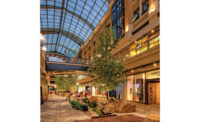The total 2.2-million-sq-ft basements, which contain 5,000 parking spaces, are built around basements for six new buildings and nine existing ones.
The 20-acre garage, linked under Main Street, is reminiscent of the 16-acre "bathtub" under the World Trade Center in New York City. In other ways as well, City Creek is like a mini-WTC, minus the tragic underpinnings of 9/11 and the intense global scrutiny.
Both basements serve many stakeholders, blurring traditional boundaries. Both are built around occupied structures. Both projects have parts that interface, overlap and interfere. And both City Creek and the WTC have many players on their projects.
City Creek has seven architect teams and about 50 consultants, including experts on pigeons and fish. "We had a lot of coordination meetings and tense moments, but nothing that couldn't be solved," says William Williams, CCRI's director of architecture and engineering.
The primary mechanical-electrical-plumbing engineer was Glumac, Seattle. CCRI brought in one structural engineer for the entire job—to "herd the cats" at the many interfaces.
MKA was "the glue," says Williams. In hindsight, he adds, CCRI should have had one architect with no design role assigned solely to oversee all the others.
Unlike the WTC, City Creek's high seismic zone complicated the project. It is also private, funded by church investments. CCRI is not releasing figures, but construction reportedly cost about $1.7 billion.
Small wonder that its nickname is the Rubik's Cube. "Everything about the project is about mixing typologies layered into an urban infill project," says Darryl Custer, a principal in the Seattle office of Callison, the project's retail design architect.
The area known as the Bermuda Triangle, where scopes of four architect teams and three contractors collide, exemplifies the job's clashes.
In the zone, new and existing buildings overlap and all elements had to be coordinated with the creek, its 18-ft-tall waterfall, a grand staircase to deal with an elevation drop and more. It was "particularly difficult to bring together," says Timothy M. Andres, a vice president of Hobbs + Black Architects, Ann Arbor, Mich.
Helping with Coordination
When H+B joined the project in late 2007, it began helping MKA coordinate the work of the various architects. H+B is architect of record for the retail, the skylight, the creek, other landscape and a 140-ft-long Main Street skywalk.
City Creek has a decade-long development saga. A couple of years into planning, the church abandoned a master plan that called for a suburban-style mall. The move delayed the retail opening by a year.
The Portland, Ore., office of Zimmer Gunsul Frasca Architects (ZGF) joined the project in 2005, a year after Taubman, to help redo the plan and design six buildings. Callison joined in April 2006.
Having heard that six architects had already been involved, "we thought this was a potential trap, a political minefield," says Stan Laegreid, a Callison principal. "We went to a meeting just to confirm this was going to be too difficult," he says, but the bishop convinced him to sign on.











Post a comment to this article
Report Abusive Comment